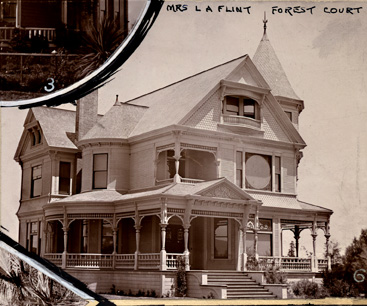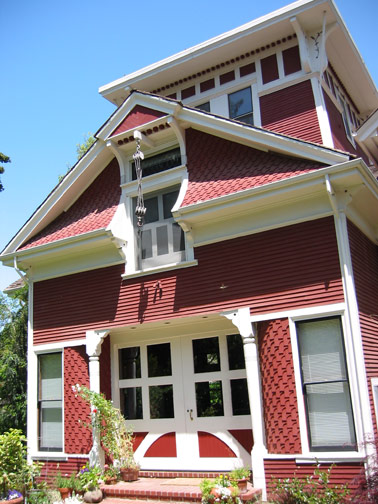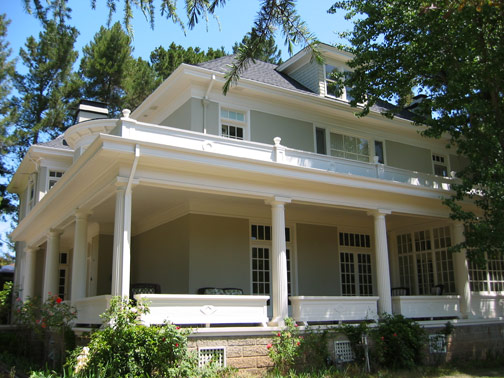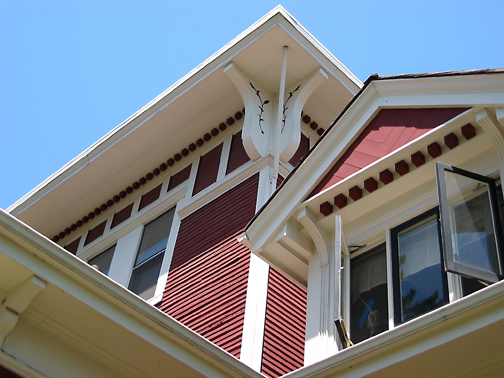 Palo Alto Stanford Heritage
Palo Alto Stanford Heritage 
Before Palo Alto became a city, Delmar and Ella Boyce Ashby owned a property bordered by Lincoln, Hamilton, Hale, Boyce and Fife streets. In 1894, they advertised four “villa” lots for sale for $450 apiece. One lot, which now encompasses 1001 Forest Avenue and its original water tank at 1009 Forest Court was purchased by Mrs. Elizabeth Stewart Flint.
The mansion at 1001 Forest was built in 1894 in a playfully turreted Queen Anne style for the extravagant price of $7000. After being damaged in the 1906 earthquake, the house was remodeled and totally transformed into a “more modern” Classical Greek Revival style. Both the original house and the remodel were built by H.L. Upham, an early Palo Alto designer and builder. The remodel is a classic example of changing architectural tastes.
The post 1906 house which we see today exhibits the restrained lines of the Greek Revival style with its low pitched roof and classic columns supporting the front and side porches. Inside, there are marble fireplace surrounds, original door hardware and a repetition of the exterior columns.
Elizabeth Stewart Flint, had come to Palo Alto in 1893 so that her children, Maude and E. Royal Flint could attend Stanford. Maude graduated in 1897 and Royal in 1901, after which he studied music in Leipzig. Royal became one of Palo Alto’s leading piano teachers and composed the Stanford University song, “Stanford Forever.” Another notable resident, from 1922 to 1965, was Fred H. Smith who not only owned Palo Alto’s first gas automobile but also opened one of its first bicycle shops in 1898 in Stanford’s Encina Gymnasium. The shop was relocated eight years later to University Circle where it was the landmark “Smith’s on the Circle” for many years.

Although the 1906 earthquake destroyed the original Queen Anne mansion at 1001 Forest, it did not destroy the water tower at the rear of the property. This building is now a private residence—1009 Forest Court. Not only is it an outstanding example of adaptive reuse but it also provides us the opportunity to envision the original architecture of the mansion in front.
The construction of this building was truly ingenious. The huge water tower, with a windmill above, sat atop a spacious area for housing horses and carriages. Such a multi purpose building had the potential for being an eyesore. Instead, its design is not only beautiful and intricate but its construction was such that it survived the ’06 earthquake unscathed.
The carriage house lay abandoned from 1913 until 1970 when R.C. Beverstock purchased it and began to convert it into a home. The current owners purchased the home in 1972 and completed its conversion. They raised five children here and did much of the renovation themselves. The building presented interesting remodeling issues. Nothing in the house is standard due to the inward slope of the walls which provided strength for the long gone water tank.

The historical flavor of the house survives both inside and out. The roof has an unusual gable treatment with the curved sweep of the lower gable end sliced for the windows, creating ear–like projections. Original wood rafters and cross–braces remain. A chimney has been built around an historic window. The second floor barn hay hook arm and wall marks in the dining room show the location of the original watering trough. The large moon window in the dining room came originally from the master house, but had been removed during its Greek Revival renovation and stored in the carriage house. The kitchen was originally two horse stalls. All the interior wood is the original fir from the carriage house as are the boxed beams. The plugged hole on the ceiling above the kitchen/dining area was used for transporting water from a from a well directly beneath it and for the mechanics of the windmill which sat atop the water tower.

Both 1001 Forest Avenue and 1009 Forest Court are listed on Palo Alto’s Historic Inventory. They provide a rare glimpse into 19th century history and prevailing architectural styles. ©
PAST, September 20, 2013
E-mail us at either webmaster@pastheritage.org or president@pastheritage.org.
![]() Palo Alto Stanford Heritage—Dedicated to the preservation of Palo Alto's historic buildings.
Palo Alto Stanford Heritage—Dedicated to the preservation of Palo Alto's historic buildings.
Copyright © 2015 Palo Alto Stanford Heritage. All rights reserved.